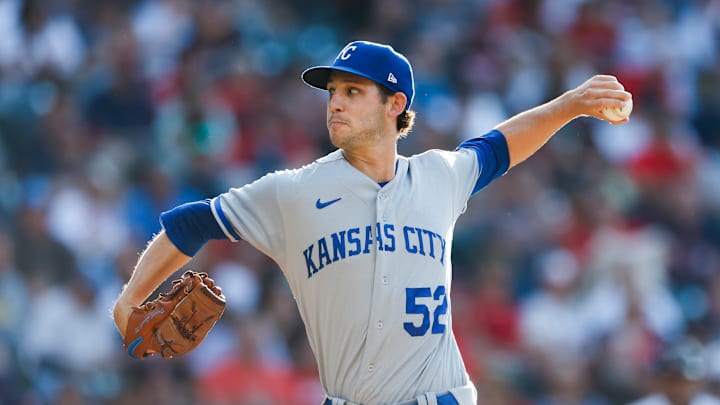The KC Royals starting rotation has not exactly been great this year, with multiple pitchers who have underperformed, are injured, or are fighting Father Time. There hasn't been a ton of bright spots outside of Kris Bubic's start to the year, even if it ended with Tommy John surgery, but one pitcher seems to have stood out above the rest.
Daniel Lynch's first-half adjustments only bolster KC Royals 2023 rotation.
Coming into the year, Lynch was in a year where he needed to show improvement, like every young player on the Royals this year, but he started the year on the injured list. Since returning on May 28 against the Nationals, Lynch has been the best starter in the KC Royals rotation.
So far in eight starts, Lynch has made three quality starts and has gone five innings in every start this season. He has really only had one bad start against the Cincinnati Reds, which he followed up with a gem against the Detroit Tigers. Anyway, let's get into the basic numbers.
Starting with the per-9s, Lynch has a K/9 of 5.89 (more on this later), a BB/9 of 2.66, and a HR/9 of 1.33. Lynch also has an ERA of 4.18, a BABIP of .252, and a 0.4 fWAR so far. That is pretty solid for Lynch, as he has made some adjustments to his repertoire.
The biggest change for Lynch this season has been his use of his changeup and slider switching. Last year, he threw his slider 30.3% of the time and his changeup 18.2%, and this year he is throwing his changeup 28.2% and his slider 18.4%. So what numbers have changed from last year to this year with that usage change?
One major change is in his batted ball profile. Last year, Lynch had a GB% of 43.0, a LD% of 26.6, and a FB% of 24.5, which is a solid profile. This year, however, he has a GB% of 39.0, a LD% of 17.5 (!!!), and a FB% of 32.5. That is a stark difference from last year's LD% and is probably one of the key factors in his solid start so far.
Another chart that has changed with his pitch usage is his run value chart. Lynch's changeup has been his best pitch for him and is tied for the lowest run value on the KC Royals, tied with Carlos Hernandez's -10 on his 4-seam fastball. Run value isn't the end all be all since it values groundballs a ton and changeups are made for that, but hitters are not hitting Lynch's changeup at all. Opposing batters are hitting .115 and slugging .148 with a wOBA of .148. That is insane for any pitcher.
To add on to the positives, Lynch isn't getting barreled as much at 7.1%, his average exit velocity is 87.6, and his hard hit percentage is 31.2, which is in the top 10% in the league. The issue is that his K-rate is super low; his K% of 15.5 ranks in the bottom 8% of the league. All the peripheral numbers say that Lynch should be better at striking guys out, but it isn't happening yet, so what is the issue.
In this writer's opinion (take it with a grain of salt), it lies in the predictability of his putaway stuff. Per Baseball Savant's pitch tracking, Lynch uses only his fastball, changeup, and slider as putaway pitches, which is fine, but the main issue lies in where those are located. He is just hitting the zone too much (raiding the zone, so to speak), and if he makes competitive pitches slightly outside the zone more often, we will see his K numbers go up.
Daniel Lynch has been a nice bright spot in a KC Royals rotation that has floundered this season. If he can start getting more Ks in the second half of the year while keeping all the positives noted throughout this piece, then he could end up being a solid middle-of-the-rotation arm for the Royals for a long time.
